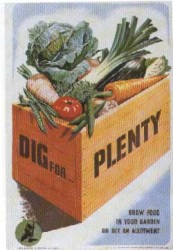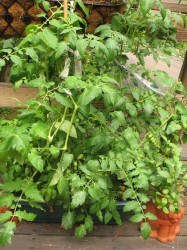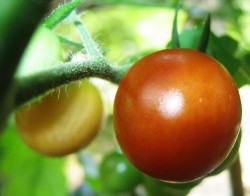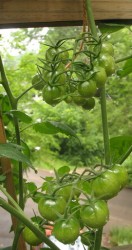Americans Return to the Garden
After I wrote a post in May entreating Americans to return to our roots and once again become “a nation of farmers” by growing at least part of our food on whatever spot of earth we can find to cultivate, I was amazed at how strongly my ideas seemed to resonate with readers.
Yesterday as I watered the forty basil plants, (we like basil here–a lot), dozen chili pepper plants, various assorted tomatoes and other herbs up on my deck, I reflected on how good it made me feel to know that in a few months I’d be harvesting a lot of tasty food just outside my kitchen door. In a small way, it brought me back to my childhood summers at Grandma’s farm, and how wonderful it was to grow, harvest, cook, preserve and eat vegetables and fruits so fresh that they tasted of the sweet sun-warmed, rain-bathed earth itself.
Of course, I still look longingly at the huge hillside in our backyard, the one that -will- be terraced within the year, dreaming of the plenitude of food, herbs and flowers we will be growing in the future, but as I do so, I cannot help but think that not only is it beautiful to grow my own food, in the future, it will be an economical choice that will help cut down our food costs as well.
It seems that I am not the only one thinking these thoughts in the United States. Other folks have decided to grow food instead of lawns this year, and many of them cite the rising cost of food as the reason for their sudden interest in vegetable and fruit gardening.
According to the New York Times, sales of vegetable and herb seeds and plants from the W. Atlee Burpee company have risen 40% in the past year–an amazingly precipitous jump that heralds a burgeoning interest in home food production that has not been seen among Americans since the 1970’s. Garden centers are selling out of vegetable and fruit plants and seeds and even potted fruit trees faster than they have in past decades as many new gardeners try out their green thumbs on full-blown kitchen gardens.
In the recent past, Americans have spent most of their gardening money and time on lawns, annual flowers, perennials, vegetables, trees and shrubs, in that order. According to a poll conducted on behalf of the Garden Writers Association, this year, American gardeners’ priorities have changed drastically as vegetables have jumped from fourth to second place.
To my ears, this is amazingly great news, because as far as I am concerned, anything that reconnects Americans to the source of our sustenance as well as getting them outside, moving and exercising in the fresh air and sunlight is wonderful. Gardening not only helps with grocery bills and overall health and fitness, it can also help us develop spiritually. There are so many lessons to be learned while digging in the dirt, pulling weeds and harvesting fruits, and I think that Americans will be the better for relearning these lessons.
Reading the New York Times article brought a smile to my face and to my heart, and I just wanted to share it with everyone here.
And while I am at it, I wanted to share some resources for gardening how-tos and inspiration, because as I imagine that many new gardeners could use a little advice on how to grow vegetables, herbs and fruits most efficiently.
For starters, look at this new article from the LA Times about a technique that allows gardeners to get great harvests with no digging and very little watering. In drought-prone areas of the country, ideas like the ones outlined in this article can help make the difference between puny yields and a bountiful harvest.
Then, check out the supplementary website for the gardening book, Food, Not Lawns. The articles there are interesting and informative and give you an idea on what the book is about, which is a call on how to turn our lawns, which are resource-guzzling areas of essentially wasted space, into productive kitchen gardens and orchards
There is always The Mother Earth News, a great magazine that is chock-full of advice on gardening, frugal living, food preservation, composting, livestock husbandry, energy production, solar power and other green topics. I was first exposed to “Mother” as the publication is known by its fans back when I was a kid, because my grandparents subscribed to it and all of us learned a great deal from it. You can order their complete back issues on CD Rom from their website and I cannot think of a better resource for all things green than that.
Grandpa also introduced me to Rodale’s Organic Gardening by my Grandpa who switched from conventional petrochemical agriculture to organic methods and ended up with higher yields in the long run, not to mention not having to worry about pesticides killing his grandkids if we came across them in the barn.
A book of interest to those of you who are looking to grow food for the first time would be Gardening When It Counts: Growing Food In Hard Times. I haven’t gotten a copy of it yet, but I have read many glowing reviews of it, and when my copy of it comes in, I will definitely review it here.
Eliot Coleman’s Four Season Harvest: Organic Vegetables from Your Home Garden All Year Long
is a manual for growing vegetables all year around through the use of inexpensive unheated hoop houses and cold frames. Coleman is a market gardener in Maine, and he sells his vegetables all through the year, and he shows how sunlight and protection from the wind are more important for growing vegetables than temperature.
Coleman also has another useful book–The New Organic Grower–which is great primer on the subject of growing vegetables organically in either a home kitchen garden or a market garden setting. It contains all sorts of useful knowledge for both beginning and advanced gardeners.
Finally, there is Edward C. Smith’s The Vegetable Gardener’s Bible: Discover Ed’s High-Yield W-O-R-D System for All North American Gardening Regions--a very useful guide to growing vegetables in a small or large garden. I really like this book myself and have used the principles outlined in it in my garden when we lived in Pataskala to great effect.
Those are just some of the possible resources for all the new gardeners out there–can any of you suggest others?
20 Comments
RSS feed for comments on this post.
Sorry, the comment form is closed at this time.
Powered by WordPress. Graphics by Zak Kramer.
Design update by Daniel Trout.
Entries and comments feeds.







Interesting article on no-dig gardens. I actually do something similar with my in-ground beds using sheet composting (the lasagna method). In fall I shred all the available leaves in the yard and throw them 4-6″ deep on the vegetable beds. These slowly decompose over the winter and I’m usually left with less than an inch in the spring. Once we start mowing the lawn, I use all of the grass clippings on the beds, keeping the layer 2-4″ deep and mix in any other available leaves or chipped wood. Kitchen vegetable scraps used to thrown in the mix also, though I started a worm bin last year so scraps go in the bin now.
Basically, the idea is to keep things heavily mulched at all times to keep things moist. This also has the secondary benefit of requiring little to no weeding. (Seriously! I weed less than 2 hours in the spring and then less than 5 minutes a week.) I almost never have to water, and when I do, try to use gray water from showers and the fish tank. My soil has also completely transformed itself in the 5yrs I’ve been gardening at this house and is now this amazing dark, rich loam.
Given all my successes, it boggles my mind that my next door neighbors still bag their grass clippings and put them on the curb instead of in their garden.
Comment by De in D.C. — June 12, 2008 #
For the past three or four years, the only thing I have been able to do is grow fresh herbs. Which I loved. This winter we bought our first house and the minute the chill left the earth we were planting and growing! I have one remaining tomato plant, some lettuce, peppers and okra. Recently planted some radishes and some spaghetti squash. I’m so excited! It’s not enough to really offset the food costs, but it gives us something to truly be proud of, especially as we try to be more locally oriented.
We also planted some berry bushes, which suprisingly have already given us a few small berries!
We have a glorious pile of compost in the corner of the yard; leaves, grass clippings, produce scraps from the kitchen, egg shells. I’m hoping that next year’s gardening will be even more successful and twice as fulfilling.
Now if I can get the rain to stop washing things away!
Comment by scotte — June 13, 2008 #
Another good resource is “Square Foot Gardening.” The concept is rooted in no-till, grid-not-line, small scale gardening that’s easy to make organic. Few of the ideas are novel but Mel Bartholomew puts it together nicely. His basic unit is a 4′ square and the basic question is “How many of X veggie do I plant in this square?” About half the book is real basics on growing specific veggies, and how to grow them in a 4′ square. There’s also information on how to do it on the cheap using reclaimed/recycled/scounged materials for you boxes and for trellises, etc.
The Gardenweb (www.gardenweb.com) used to be terrific; I haven’t been there much since iVillage bought it (the timing was coincidental, I have nothing against iVillage). There are a couple hundred forums for specific gardening subjects. I spent a lot of time at Soil Compost & Mulch, Frugal Gardening, and Square Foot Gardening. (You’ll notice there’s a lot of overlap between the ideas.) For some reason I’m a pathetic veggie gardener – I’ve just killed my umpteenth rosemary plant – but boy, I can build you superb soil under any conditions, either fast and costly or slow and cheap.
While I have y’all on the line, what resources can you suggest that till turn my black thumb green? For all my time with SFG and the Gardenweb and my MIL’s big fat books, I still kill almost any food plant. I can’t do peas (which is what I most want to grow), I can’t do herbs, my garlic was the size of a pea. I’ve even killed mint! The only thing I managed is radishes. Assuming I can’t find a local to give me personal advice, what can you suggest?
Comment by Harry — June 13, 2008 #
PS – the reviews on Amazon say the original version of Square Foot Gardening is more useful than the updated.
Comment by Harry — June 13, 2008 #
what an immensely useful post. thank you, dear barbara.
Comment by bee — June 13, 2008 #
Lovely, and well-timed (in my case, anyway) as usual. I’m moving into a country apartment on a horse farm and have been racking my brain for growing ideas. Originally I was going to make an old grill into a planter, and line some hanging three-tier bread baskets with planting mats for a hanging air garden. But if it’s not too late in the season for Georgia, I may try to make a no-dig garden at this new place. And even if I don’t, I’ll likely be using this method when I move back home to Kentucky (a little closer to your zone, Barbara). Is there a mulch that would be a suitable sub for compost, maybe with a little tweaking? Or bagged compost (though I’m loathe to buy compost when I could make it)?
Wonderful article! Thank you for posting it.
Kate
Comment by Kate — June 13, 2008 #
Hey, look! Two Kates in a row! 🙂
I’ve found that raised beds are a wonderful thing. I also discovered containers are great workhorses for those who can’t have a proper garden, but still want to grow food. The trick is to make sure you’ve got adequate drainage, and that your pot is of a material that won’t allow your soil to dry out too quickly. The traditional clay “strawberry pots” have NEVER worked for me.
If you haven’t gotten into heirloom plants, I urge you to check these people out:
http://www.seedsavers.org/
Seed Savers Exchange – heirloom plants including flowers, vegetables, squash, and more. I dream of visiting their farm someday. I’ve been ordering from them for years and absolutely LOVE them.
Comment by Kate L. — June 13, 2008 #
My neighbors have a couple of raised beds and I’m thinking that maybe the way I should go. Great read!
Comment by jeff-naturehills — June 13, 2008 #
Has anyone used “Gardening When It Counts”? The Amazon summary says the method calls for thousands of square feet and 2 hrs/day during growing season?!?
Comment by Harry — June 13, 2008 #
It’s so encouraging to see this kind of increase in gardening. If we had more than a 4’x6′ section of above-ground planter in which to garden (ah, apartment life), we’d be using John Jeavons’ Grow Biointensive method. Some of the benefits, as listed on their website:
My husband and I took a class from Jeavons a while ago, and as we were leaving afterwards, my husband (Mr. “I grew up in New York City, where trees grow in 3’x3′ patches of dirt in the sidewalk, the way God intended them to”) said pensively, “That… that was an epiphany.”
And lately I find myself looking at vacant lots and empty median strips around Oakland and thinking “Hmmm… guerrilla gardening, you say?”
Comment by Lexica — June 13, 2008 #
Someone already mentioned John Jeavons and the Grow Biointensive method. The book detailing that method, How to Grow More Vegetables, is an amazing resource.
Also, check out the folks at Path to Freedom and their sister site Freedom Gardens.
Comment by Mist — June 13, 2008 #
I really am glad you mentioned about seeling lawns and stuff as wasted space. What really makes me crazy out here is food plants as wasted space! People & governments grow beautiful citrus trees, rosemary, etc. and a lot of it is sprayed or just left to rot. Makes me cringe. Useful plants treated as purely ornamental instead of thinking about how to make things both functional and pretty. Agh.
I really want to start gardening myself but I’ll have to get containers and I haven’t really got anywhere to put them given the way my apartment & surrounds are shaped. It’s annoying. Same thing — no thought given to being both useful and pretty.
Comment by Alexis — June 13, 2008 #
Thank you for these wonderful garden posts! I was out planting squash, peppers, beans and eggplant today as well as watering everything else. My parents have always had an organic garden, both sets of grandparents too and I am proud to carry on that tradition.
When I bought this house there were only a few scrawny petunias and a sad sand box with some dead flowers in it. The sandbox became my salad garden, with a healthy helping of peat moss, the front and side yard has been planted with flowers and herbs. Vegetables and Jerusalem Artichokes are beside the garage and I keep looking at the rest of the grass with murder in my eyes. Mowing sux, I’d rather weed.
I also wanted to share the new gardening forum on American Metaphysics. It’s still small, but a good place for help!
Comment by John Thornton — June 13, 2008 #
I have been home gardening herbs on my tiny Chicago fire-escape (when I’m feeling indulgent, I call it my porch, but that is a bit dillusional). I bring the pots in and nurse them through the winter.
I’m not a natural gardener, so I’ve learned a lot from my mistakes along the way.
Thanks for all these interesting resources and advice. I’m growing tomatoes and peppers for the first time, so I’ve got my fingers crossed.
Comment by Erin @ The Skinny Gourmet — June 14, 2008 #
I’ve been able to grow herbs on my tiny back porch – there’s nothing to beat the taste of fresh basil or mint.
Comment by Nancy — June 14, 2008 #
4 years ago, when we move here to French farm country, I bought a ‘vegetable freezer’ and have filled it every summer from my potager. I am so sad that I can’t have one this year (sold the house…we think) And last year our tomatoes all got fungus and died (as did everyone else’s) But next year….. I can’t wait.
It’s nice to see the trend returning to the U.S.
Comment by katie — June 15, 2008 #
I have spent the spring planting veggies, and it is only this weekend that I have attended to my flower beds…I want to keep a balance, tho, as the beauty of my flowers feeds my soul, if not my stomach…
Comment by Jean Ann Van Krevelen — June 16, 2008 #
Me a housewife so liked to do different recipe for my hubby.Searched the recipe from your best collection of sites package user I got the required one. Thanks for the Visitthebest team.
Comment by Best Garden Websites Guide — June 18, 2008 #
Barbara, I sent you a message a couple of weeks ago about a great book I’m reading that is – I think – right up your alley. Barbara Kingsolver’s Animal, Vegetable, Miracle is a fantastic book about the merits of growing your own, buying locally, buying and growing organic. Reading it made me feel like I was reading a series of long thoughtful posts by you. Seriously, if you don’t know her, she should be your best friend!
And to everyone else – even if you are mildly interested in gardening and buying locally this book will seriously push you over the edge into total Hippy-dom!
I currently have about a dozen potato plants in our terrace planters, a dozen tomato plants, a variety of herbs and strawberries and a couple of zucchini plants that are struggling to survive under the jungle growth of potatoes. And I live in the middle of Paris – all you really need is a bit of time and a bit of outdoor space (in our case a large terrace)!
Comment by Meg — June 19, 2008 #
One of my favorite Southern California resources for growing food instead of lawns is a book titled The Year I Ate My Yard, by Tony Kienitz. It is helpful, philosophical, and darned funny. Also of interest to people in my neck of the woods is an exhibit at Descanso Gardens right now by Fritz Haeg called Edible Estates; it encourages the typical American to eliminate the lawn and plant food instead.
Comment by Christina — June 21, 2008 #